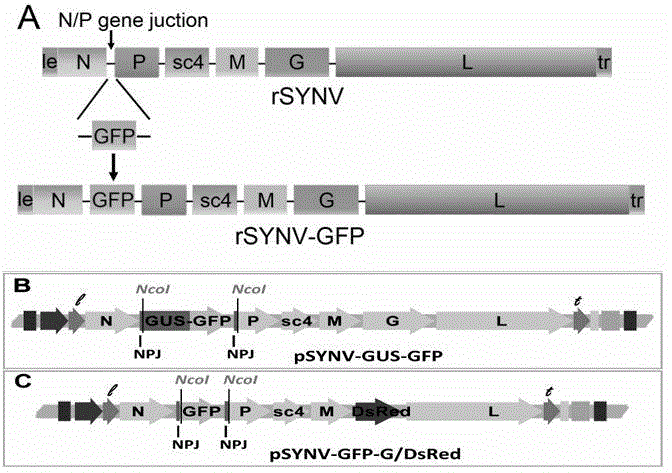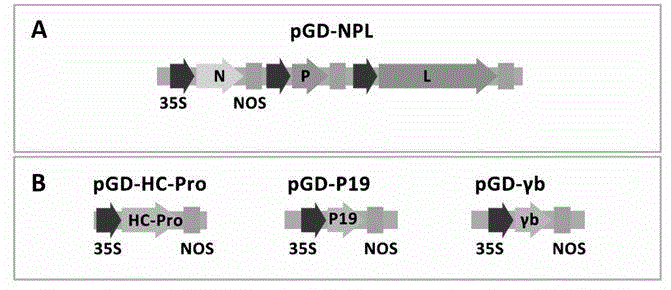Recombinant plant rhabdovirus vector and construction method thereof
A plant rhabdovirus and vector technology, applied in the fields of botany equipment and methods, biochemical equipment and methods, plant genetic improvement, etc. To solve problems such as genetics, to achieve the effect of good repeatability, broad application prospects and simple operation
- Summary
- Abstract
- Description
- Claims
- Application Information
AI Technical Summary
Problems solved by technology
Method used
Image
Examples
Embodiment 1
[0044] Example 1. SYNV cDNA transcription vector construction
[0045] The SYNV genome is a single-stranded negative-sense RNA with a length of about 13.7 kb. Total RNA was extracted from leaves of Nicotiana benthamiana infected with SYNV, and used as a template for reverse transcription PCR to obtain full-length genome cDNA. The full-length cDNA was cloned into the plant expression vector pCB301 to obtain the SYNV cDNA transcription vector, named pSYNV, and pSYNV was introduced into Agrobacterium GV3101 by electroporation.
[0046] The construction process of infecting pSYNV transcription vector comprises the following steps:
[0047] 1) Extract total RNA from SYNV-infected Nicotiana benthamiana leaves:
[0048] Take 0.1 g leaves, add liquid nitrogen and grind into powder; quickly transfer the powder to a pre-cooled 1.5 mL centrifuge tube, and quickly add pre-cooled 1 mL TRIzol extract; mix up and down, fully lyse, and place at room temperature for 5 min; 0.2 mL of chlorof...
Embodiment 2
[0055] Example 2. RNP core protein expression vector construction
[0056]The ribonucleoprotein RNP core of SYNV includes three proteins, N, P and L. These three proteins are inserted into the same expression vector at the same time to obtain pGD-NPL. In this expression vector, the three proteins are driven by different 35S promoters and NOS transcription terminator control, that is to say, the same expression vector contains three expression cassettes, expressing N, P and L respectively ( figure 2 .A).
[0057] The above four expression vectors were electroporated into Agrobacterium GV3101 respectively.
Embodiment 3
[0058] Example 3. Viral RNA silencing suppressor protein expression vector construction
[0059] Three RNA silencing suppressors encoded by other viruses: tobacco etch virus (Tobacco etch virus, TEV) Hc-Pro gene, tomato bushy stunt virus (TBSV) P19 gene and barley stripe mosaic virus ( Barley stripe mosaic virus, BSMV) γb gene. These three silencing suppressors were respectively inserted into pGD vectors to obtain three expression vectors: pGD-Hc-Pro, pGD-P19 and pGD-γb ( figure 2 .B).
[0060] The above three silencing suppressor expression vectors were introduced into Agrobacterium GV3101 by electroporation respectively.
PUM
 Login to View More
Login to View More Abstract
Description
Claims
Application Information
 Login to View More
Login to View More - R&D
- Intellectual Property
- Life Sciences
- Materials
- Tech Scout
- Unparalleled Data Quality
- Higher Quality Content
- 60% Fewer Hallucinations
Browse by: Latest US Patents, China's latest patents, Technical Efficacy Thesaurus, Application Domain, Technology Topic, Popular Technical Reports.
© 2025 PatSnap. All rights reserved.Legal|Privacy policy|Modern Slavery Act Transparency Statement|Sitemap|About US| Contact US: help@patsnap.com



